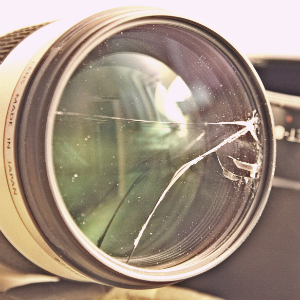
image by flikr user puuikibeach
One of the most troubling moments a photographer can experience is when their lens starts acting up. Many lenses cost more than the camera and usually cost more to fix. There are a lot of different symptoms and some of them people easily just shrug off and continue shooting. Lenses are highly complex and complicated pieces of equipment, all it takes is one small flaw which magnifies and destroys it. Fortunately those problems aren’t all that hard to recognize once you know what to look for.
Zoom functionality is most commonly ignored when there are issues. The camera still takes pictures and, depending on the severity, it may not seem to affect the overall use of the lens. When it feels gritty or scratchy it has been most likely exposed to sand or dirt. If it is left unchecked the particulates can work down the gears causing real damage. Another common problem is when the zoom becomes stiff or catches. If you have a large zoom (18-200 etc.) and are unsure if you have a problem, the best test you can try at home is to turn it upside down and try it out. If it still catches you will probably want to have it looked at. The other side of the coin is having lens barrels that are too loose and/or wobbling components. It might just need a tightening up and will prevent further damage. Of course when you have clicking, scraping or any rattling inside the lens that is definitely a bad sign and needs to be serviced; this can occur from impact or from continued use of the aforementioned issues.
Next there is the focus. Basically all of the things to worry about from the previous paragraph can be applied to the focusing mechanism. Added to it, if there is focus straining, stopping or stuttering it is time to get it checked out. Not all AF issues are due to bad AF though, sometimes it can be large build up of dust on lens elements. In one of our previous posts we discussed how a little dust in the lens is nothing to be worried about because the light bends around it; emphasis on little. Dust, when it builds up, can also do as much damage as sand and dirt. Another thing to watch out for with dust build up is that it can make your images look blurred and hazy. Vibration reduction, image stabilization or whatever your manufacturer calls it can also malfunction and make it seem like there is an auto focusing problem. Vibration, random jumping and all around odd behavior are signs of it not working. Turning that off won’t always fix your problem either because it has to be energized to stay in place too. Testing it isn’t too difficult, turn off your AF, focus manually and see if you are still having that issue.
The dreaded error messages; when you get an error message it means that your camera and your lens are not communicating properly. It can be a little tricky because it could be the lens but it could also be the body. Test both with other units. If you are using an older lens with a manual aperture ring many times you just bumped it off of its “auto†spot.
So what do you do when your lens is acting funny or making funny noises? Easy, stop using your lens so it doesn’t get damaged any further and have it looked at or cleaned by repair professionals. Sometimes it is easy to get caught up in the moment for the photo you want but it can really hurt in the long run. The best advice we can give (other than to just stop altogether) is to do a cost-benefit analysis. For instance, if you are a Pro and the shot you need outweighs the cost of repairs or a new lens then take a chance; if you are at the zoo with the family and it starts acting up you may just want to let this trip go. Just remember, lens issues tend to start small and compound with use. It is in your best interest to get it taken care of when it is still a manageable repair.